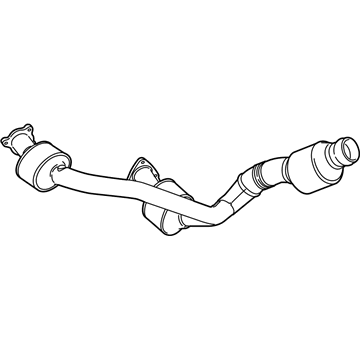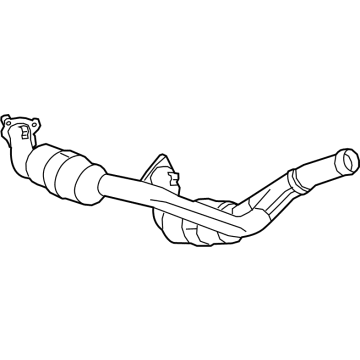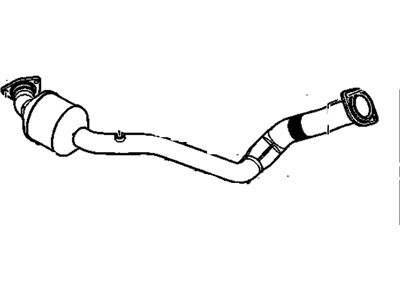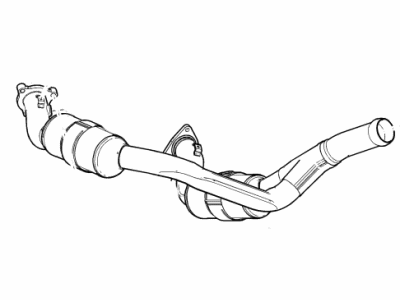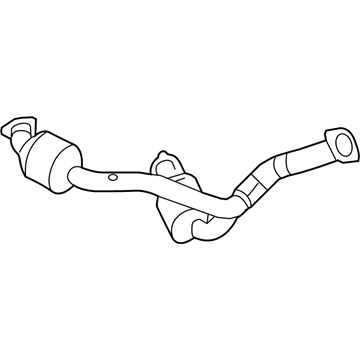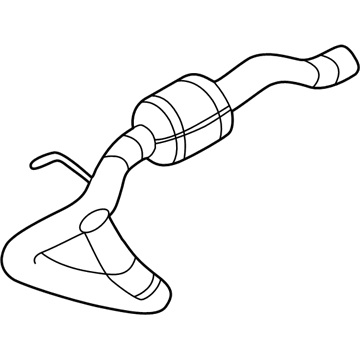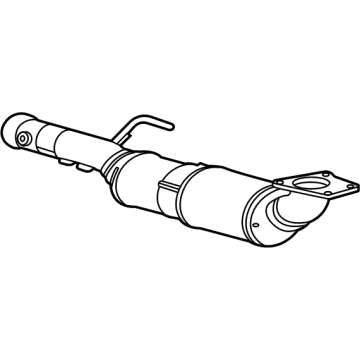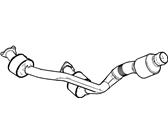
My Garage
My Account
Cart
Genuine Cadillac Escalade Catalytic Converter
Cat. Converter- Select Vehicle by Model
- Select Vehicle by VIN
Select Vehicle by Model
orMake
Model
Year
Select Vehicle by VIN
For the most accurate results, select vehicle by your VIN (Vehicle Identification Number).
34 Catalytic Converters found
Cadillac Escalade CONVERTER ASM,3WAY CTLTC(W/EXH PIPE)
Part Number: 19420265$1974.47 MSRP: $2965.42You Save: $990.95 (34%)Cadillac Escalade CONVERTER ASM,3WAY CTLTC(W/EXH PIPE)
Part Number: 19420284$2213.10 MSRP: $3325.33You Save: $1112.23 (34%)Ships in 1-3 Business DaysCadillac Escalade CONVERTER ASM-3WAY CTLTC(W/EXH PIPE)
Part Number: 85542368$1164.03 MSRP: $1743.03You Save: $579.00 (34%)Ships in 1-3 Business DaysCadillac Escalade CONVERTER ASM,3WAY CTLTC (W/EXH MANIF PIPE)"KIT"
Part Number: 19418932$3174.43 MSRP: $3954.87You Save: $780.44 (20%)Ships in 1-3 Business DaysCadillac Escalade CONVERTER ASM,3WAY CTLTC (W/EXH MANIF PIPE) "KIT"
Part Number: 19420124$965.73 MSRP: $1443.93You Save: $478.20 (34%)Cadillac Escalade CONVERTER ASM-3WAY CTLTC(W/EXH PIPE)
Part Number: 86781749$1164.03 MSRP: $1743.03You Save: $579.00 (34%)Ships in 1-2 Business DaysCadillac Escalade Converter Assembly, 3Way Ctltc(W/Exh Pipe)
Part Number: 84769824$966.08 MSRP: $1444.48You Save: $478.40 (34%)Ships in 1-3 Business DaysCadillac Escalade CONVERTER ASM,3WAY CTLTC (W/EXH MANIF PIPE)"KIT"
Part Number: 19418941$2235.38 MSRP: $3358.95You Save: $1123.57 (34%)Ships in 1-3 Business DaysCadillac Escalade CONVERTER ASM,3WAY CTLTC (W/EXH MANIF PIPE)"KIT"
Part Number: 19418958$1491.20 MSRP: $2236.50You Save: $745.30 (34%)Ships in 1-3 Business DaysCadillac Escalade CONVERTER ASM,3WAY CTLTC (W/EXH MANIF PIPE)"KIT"
Part Number: 19418926$2080.19 MSRP: $3134.37You Save: $1054.18 (34%)Cadillac Escalade CONVERTER ASM,3WAY CTLTC (W/EXH MANIF PIPE) "KIT"
Part Number: 19420109$929.35 MSRP: $1389.07You Save: $459.72 (34%)Ships in 1-3 Business DaysCadillac Escalade CONVERTER ASM-NOX CTLTC (W/ FLTR)
Part Number: 40009042$1058.15 MSRP: $1583.33You Save: $525.18 (34%)Ships in 1-3 Business DaysCadillac Escalade CONVERTER ASM-3WAY CTLTC(W/EXH PIPE)
Part Number: 85542367$1322.22 MSRP: $1981.63You Save: $659.41 (34%)Ships in 1-2 Business DaysCadillac Escalade 3Way Catalytic Convertor Assembly (W/ Exhaust Manifold P)
Part Number: 22940415$1887.92 MSRP: $2834.87You Save: $946.95 (34%)Ships in 1-2 Business DaysCadillac Escalade CONVERTER ASM-NOX CTLTC (W/ FLTR)
Part Number: 40009139$1058.15 MSRP: $1583.33You Save: $525.18 (34%)Cadillac Escalade CONVERTER ASM-NOX CTLTC (W/ EXH PIPE)
Part Number: 85521780$204.46 MSRP: $294.38You Save: $89.92 (31%)Ships in 1-3 Business DaysCadillac Escalade CONVERTER ASM-3WAY CTLTC(W/EXH PIPE)
Part Number: 85558398$325.35 MSRP: $488.52You Save: $163.17 (34%)Ships in 1-3 Business DaysCadillac Escalade CONVERTER ASM-3WAY CTLTC(W/EXH PIPE)
Part Number: 85558399$123.64 MSRP: $185.65You Save: $62.01 (34%)Ships in 1-3 Business DaysCadillac Escalade CONVERTER ASM,3WAY CTLTC (W/EXH MANIF PIPE) "KIT"
Part Number: 19419599$1933.40 MSRP: $2903.47You Save: $970.07 (34%)Cadillac Escalade CONVERTER ASM,3WAY CTLTC (W/EXH MANIF PIPE) "KIT"
Part Number: 19420113$1829.79 MSRP: $2747.21You Save: $917.42 (34%)
| Page 1 of 2 |Next >
1-20 of 34 Results
Cadillac Escalade Catalytic Converter
The Cadillac Escalade comes with a catalytic converter part of exhaust system that is responsible for converting dangerous gases from an engine to harmless fumes. This is done by way of redox reactions using catalysts which are usually metals derived from the platinum group which includes platinum, palladium and rhodium. In the past Cadillac Escalade models installed catalytic converters with ceramic bead style while the current models use honey comb type to facilitate better flow of exhaust fumes. The truth is that being a converter, it is subjected to constant attack from particles reaching the engine, and further to age, it can clog or get damaged and thus deteriorate the engine's performance, economy and emissions. Some symptoms of a bad catalytic converter in Cadillac Escalade include on your dashboard you will see the check engine light, you may hear an abnormal vibration or humming sound from the converter, and often the car may fail smog test. Due to the importance of this part in reducing the emission, the catalytic converter requires maintenance and proper replacement now and then to enhance the functioning of a car to its optimal optimal.
Each OEM Cadillac Escalade Catalytic Converter we offer is competitively priced and comes with the assurance of the manufacturer's warranty for the part. Furthermore, we guarantee the speedy delivery of your orders right to your doorstep. Our hassle-free return policy is also in place for your peace of mind.
Cadillac Escalade Catalytic Converter Parts Questions & Experts Answers
- Q: What should you consider before replacing a catalytic converter due to a federally-mandated extended warranty on Cadillac Escalade?A:Due to a Federally-mandated extended warranty covering emission-related components like the catalytic converter, it's advisable to consult a dealer service department before incurring replacement costs. A catalytic converter is an emission control device in the exhaust system that reduces pollutants in the exhaust gas stream, with two types: oxidation catalysts that reduce hydrocarbons and carbon monoxide, and reduction catalysts that reduce oxides of nitrogen. Vehicles equipped with three-way catalysts can reduce all three pollutants. If a malfunction is suspected, diagnostic testing should be performed at a dealer or authorized emission inspection facility, and the converter should be inspected for leaks, corrosion, dents, and damage whenever the vehicle is raised for service. Although failures are rare, plugged converters can be diagnosed using a vacuum gauge to assess the impact of a blocked exhaust on intake vacuum. If the fourth reading is significantly lower than the idle reading, the exhaust system may be restricted. Catalytic converters are integral to the front exhaust pipe assembly, which connects the exhaust manifolds to the rest of the exhaust system. To replace the converter, raise the vehicle securely, disconnect the electrical connectors for the Oxygen Sensors, and remove the sensors. Detach the upper flanges securing the front exhaust pipe assembly to the exhaust manifold, then remove the clamp connecting the rear of the assembly to the exhaust system. Discard old flange gaskets and ensure new gaskets and fasteners are used. Apply anti-seize compound to the threads of the nuts and bolts, tighten them securely, and follow the reverse order for installation.
Related Cadillac Escalade Parts
Browse by Year
2024 Catalytic Converter 2023 Catalytic Converter 2022 Catalytic Converter 2021 Catalytic Converter 2020 Catalytic Converter 2019 Catalytic Converter 2018 Catalytic Converter 2017 Catalytic Converter 2016 Catalytic Converter 2015 Catalytic Converter 2014 Catalytic Converter 2013 Catalytic Converter 2012 Catalytic Converter 2011 Catalytic Converter 2010 Catalytic Converter 2009 Catalytic Converter 2008 Catalytic Converter 2007 Catalytic Converter 2006 Catalytic Converter 2005 Catalytic Converter 2004 Catalytic Converter 2003 Catalytic Converter 2002 Catalytic Converter 2000 Catalytic Converter 1999 Catalytic Converter
